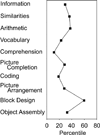The level and nature of autistic intelligence
- PMID: 17680932
- PMCID: PMC4287210
- DOI: 10.1111/j.1467-9280.2007.01954.x
The level and nature of autistic intelligence
Abstract
Autistics are presumed to be characterized by cognitive impairment, and their cognitive strengths (e.g., in Block Design performance) are frequently interpreted as low-level by-products of high-level deficits, not as direct manifestations of intelligence. Recent attempts to identify the neuroanatomical and neurofunctional signature of autism have been positioned on this universal, but untested, assumption. We therefore assessed a broad sample of 38 autistic children on the preeminent test of fluid intelligence, Raven's Progressive Matrices. Their scores were, on average, 30 percentile points, and in some cases more than 70 percentile points, higher than their scores on the Wechsler scales of intelligence. Typically developing control children showed no such discrepancy, and a similar contrast was observed when a sample of autistic adults was compared with a sample of nonautistic adults. We conclude that intelligence has been underestimated in autistics.
Figures



Similar articles
-
The level and nature of autistic intelligence II: what about Asperger syndrome?PLoS One. 2011;6(9):e25372. doi: 10.1371/journal.pone.0025372. Epub 2011 Sep 28. PLoS One. 2011. PMID: 21991394 Free PMC article.
-
Brief report: The level and nature of autistic intelligence revisited.J Autism Dev Disord. 2009 Apr;39(4):678-82. doi: 10.1007/s10803-008-0667-2. Epub 2008 Dec 4. J Autism Dev Disord. 2009. PMID: 19052857
-
The level and nature of autistic intelligence III: Inspection time.J Abnorm Psychol. 2013 Feb;122(1):295-301. doi: 10.1037/a0029984. Epub 2012 Oct 22. J Abnorm Psychol. 2013. PMID: 23088375
-
Cross-cultural differences in visuo-spatial processing and the culture-fairness of visuo-spatial intelligence tests: an integrative review and a model for matrices tasks.Cogn Res Princ Implic. 2022 Feb 4;7(1):11. doi: 10.1186/s41235-021-00350-w. Cogn Res Princ Implic. 2022. PMID: 35119577 Free PMC article. Review.
-
Value and limitations of preschool cognitive tests, with an emphasis on longitudinal study of children on the autistic spectrum.Brain Dev. 2003 Dec;25(8):546-8. doi: 10.1016/s0387-7604(03)00127-x. Brain Dev. 2003. PMID: 14580667 Review. No abstract available.
Cited by
-
Disorder-Specific Alteration in White Matter Structural Property in Adults With Autism Spectrum Disorder Relative to Adults With ADHD and Adult Controls.Hum Brain Mapp. 2017 Jan;38(1):384-395. doi: 10.1002/hbm.23367. Epub 2016 Sep 15. Hum Brain Mapp. 2017. PMID: 27630075 Free PMC article.
-
Abstract spatial reasoning as an autistic strength.PLoS One. 2013;8(3):e59329. doi: 10.1371/journal.pone.0059329. Epub 2013 Mar 22. PLoS One. 2013. PMID: 23533615 Free PMC article.
-
Replicated linear association between DUF1220 copy number and severity of social impairment in autism.Hum Genet. 2015 Jun;134(6):569-75. doi: 10.1007/s00439-015-1537-6. Epub 2015 Mar 11. Hum Genet. 2015. PMID: 25758905 Free PMC article.
-
The role of timing in testing nonverbal IQ in children with ASD.J Autism Dev Disord. 2013 Jan;43(1):80-90. doi: 10.1007/s10803-012-1545-5. J Autism Dev Disord. 2013. PMID: 22555367
-
A convergent structure-function substrate of cognitive imbalances in autism.Cereb Cortex. 2023 Feb 20;33(5):1566-1580. doi: 10.1093/cercor/bhac156. Cereb Cortex. 2023. PMID: 35552620 Free PMC article.
References
-
- Baird G, Charman T, Baron-Cohen S, Cox A, Swettenham J, Wheelwright S, Drew A. A screening instrument for autism at 18 months of age: A 6-year follow-up study. Journal of the American Academy of Child and Adolescent Psychiatry. 2000;39:694–702. - PubMed
-
- Blair C. How similar are fluid cognition and general intelligence? A developmental neuroscience perspective on fluid cognition as an aspect of human cognitive ability. Behavioral and Brain Sciences. 2006;29:109–125. - PubMed
-
- Burke HR. Raven’s Progressive Matrices (1938): More on norms, reliability, and validity. Journal of Clinical Psychology. 1985;41:231–235.
-
- Caron M-J, Mottron L, Berthiaume C, Dawson M. Cognitive mechanisms, specificity and neural underpinnings of visuospatial peaks in autism. Brain. 2006;129:1789–1802. - PubMed
-
- Carpenter PA, Just MA, Shell P. What one intelligence test measures: A theoretical account of the processing in the Raven Progressive Matrices Test. Psychological Review. 1990;97:404–431. - PubMed
Publication types
MeSH terms
Grants and funding
LinkOut - more resources
Full Text Sources

